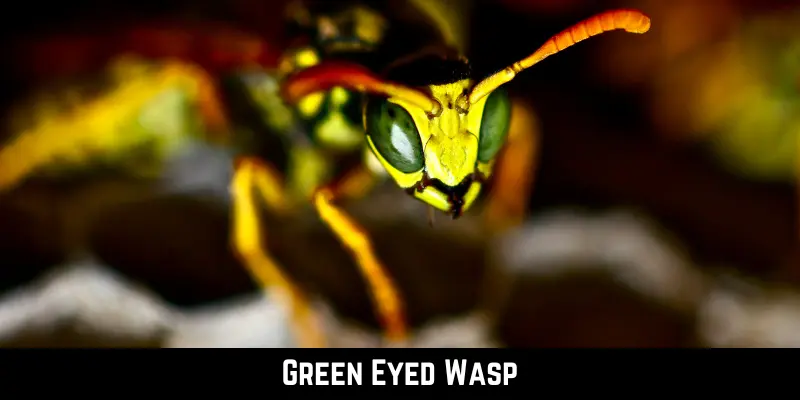In the big world of bugs, the Green Eyed Wasp stands out. Why? Because it’s special and interesting. Have you ever heard of the green-eyed wasp?
This isn’t just a regular bug flying around your garden. It’s a mix of beauty and interesting facts. Many people, both bug experts and people, find it amazing.
In this article, we will learn more about this cool wasp. Let’s find out together why the Green wasp is so special. Keep reading, and get ready to be surprised!
| Category | Description |
| Kingdom | Animalia |
| Phylum | Arthropoda |
| Class | Insecta |
| Order | Hymenoptera |
| Family | Vespidae |
| Genus | Varies (depending on the specific wasp) |
| Species | Varies (depending on the specific wasp) |
| Scientific Name | Varies (e.g., Vespula vulgaris for the common wasp) |
| Category | Insect |
| Size (Adult; | Typically from 1 cm to several centimeters |
| Length) | |
| Colors | Body: black, yellow, brown, or metallic blue/green. Eyes: can sometimes be green. |
| Descriptors | Narrow waist, wings, can sting repeatedly |
Physical Characteristics of Green-Eyed Wasp
Nature has made many beautiful creatures, and the wasp is one of them. Its body has been shaped and changed over a very long time. Every part of the wasp, like its curves and points, tells a story of where it’s been and what it’s been through. It shows how the wasp has lived, faced challenges, and succeeded in the wild.
Size and Appearance
Looking at a wasp is like seeing nature’s great work. Even though they can be very small or a bit larger, they always catch your eye, just like a small shiny diamond stands out among other jewels.
The colors and patterns on a wasp are really special. They might be black like a dark night, orange like a sunset, or shiny green and blue like clean water. These colors aren’t just pretty; they help the wasp live. They can hide the wasp, warn others to stay away, or attract friends. The patterns on their bodies are like secret signs, like how some people have tattoos that mean something important.
When you see a wasp, it’s like seeing how careful and smart nature is. Everything about the wasp is made just right. Watching a wasp helps us learn more about the world and how everything in nature has its own special place and purpose.
The Green Eyes
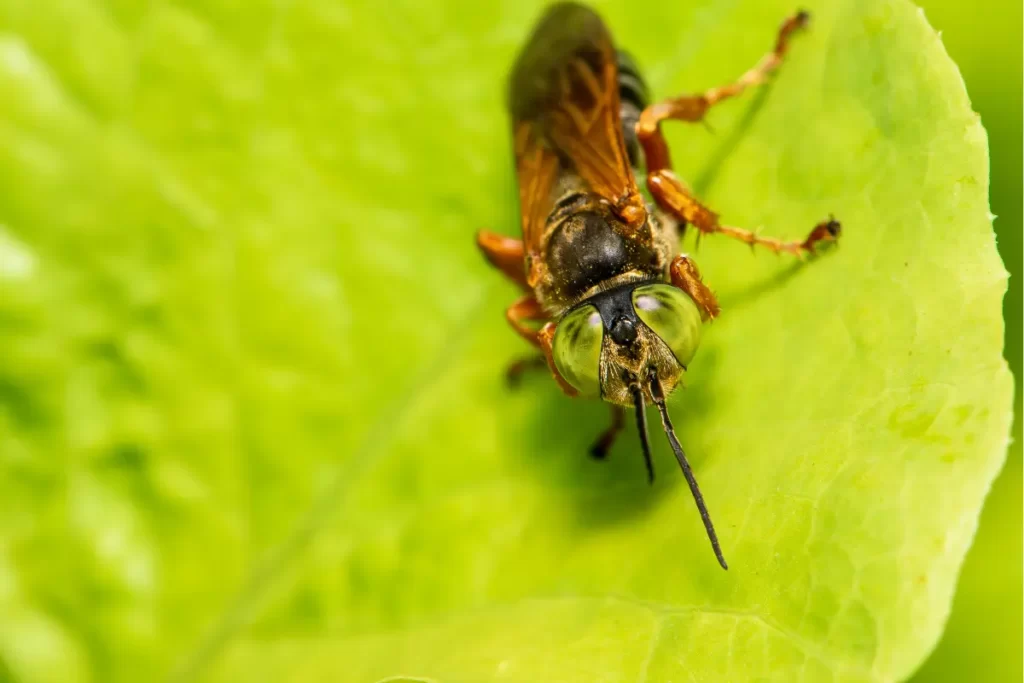
The wasp’s green eyes are truly amazing to look at. Inside these eyes, there’s so much happening. They don’t just see things; they help the wasp understand its world. Their bright green color reminds us of lively forests and fields where the wasp lives. These eyes have been shaped over a long time to work perfectly.
Inside these green eyes, there are special parts that catch different kinds of light. This helps the wasp notice even the smallest changes around it, like a moving bug it might eat or a bigger bug that might try to eat it. These eyes don’t just work well. They also look beautiful. They add a special touch of color that makes the wasp stand out from other bugs.
Wings and Flight
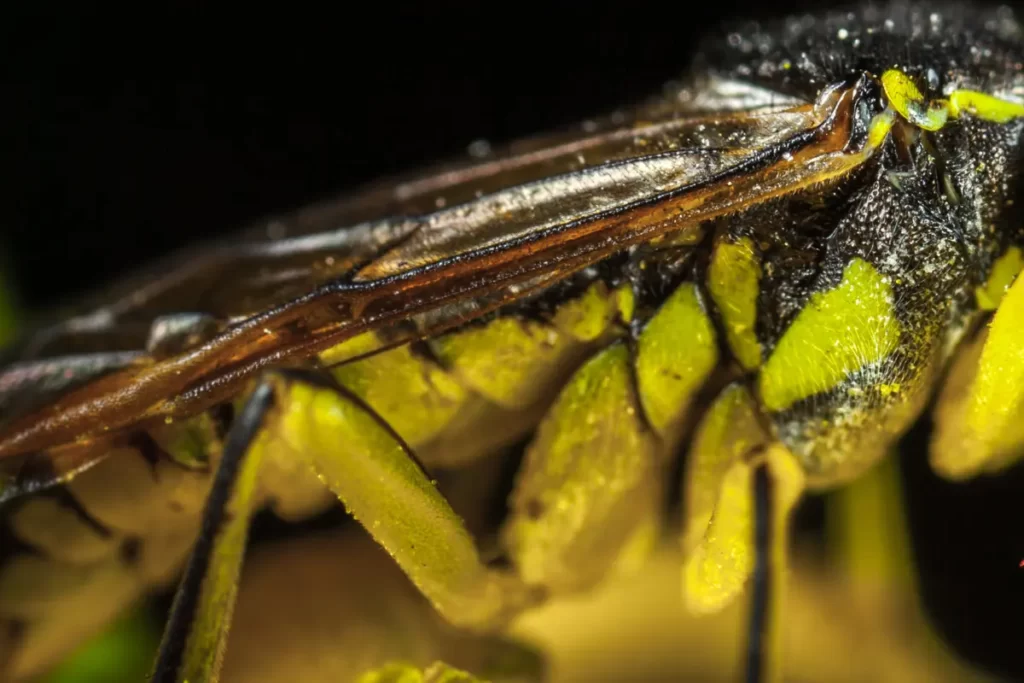
The wasp’s wings are a great example of how smart nature is. They are built just right for flying. Every time a wasp moves its wings, it’s like watching a perfect dance in the air. These wings have a special design, with tiny lines supporting a thin skin, that helps the wasp fly for a long time and move quickly.
Watching a wasp fly is like seeing a piece of art. It can change direction, go up and down, and move its body in just the right way. This helps the wasp fly through tricky places, get away from danger, chase food, and find the best places to live.
The way a wasp flies shows us how well nature can design things. Whether it’s going up fast or coming down slowly, turning sharply or gliding smoothly, the wasp does it all. Among all the bugs, the wasp’s way of flying is really special and amazing to watch.
Habitat
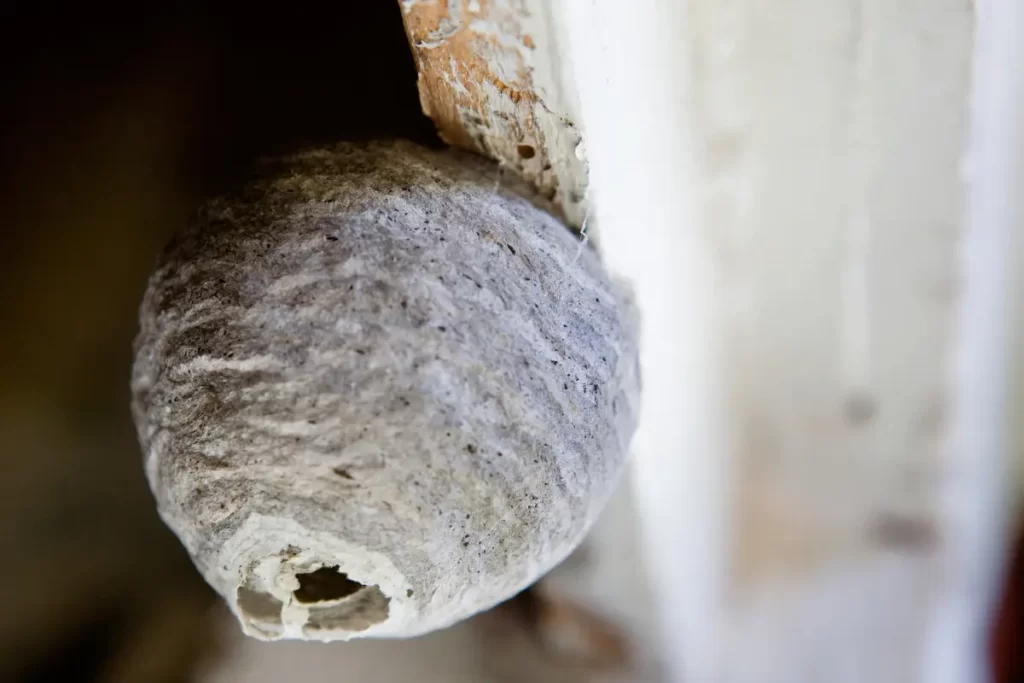
Wasps are smart about where they live. They pick safe spots, have lots of food, and protect them from bad weather. They can live in many places, like holes in the ground, on tree branches, or even in buildings made by people. By knowing where they like to live, we can learn more about what they do every day.
Geographic Locations
| Continent | Details |
| North America | Across various regions, from gardens to forests. |
| Europe | Common in meadows, parks, and woodlands. |
| Asia | Found in diverse settings, from rural to urban areas. |
| Africa | Mostly in open lands and grassy regions. |
| Australia | In coastal areas, forests, and human dwellings. |
| South America | Predominantly in tropical rainforests and plains. |
| Antarctica | Not present due to extreme cold conditions. |
Preferred Living Conditions
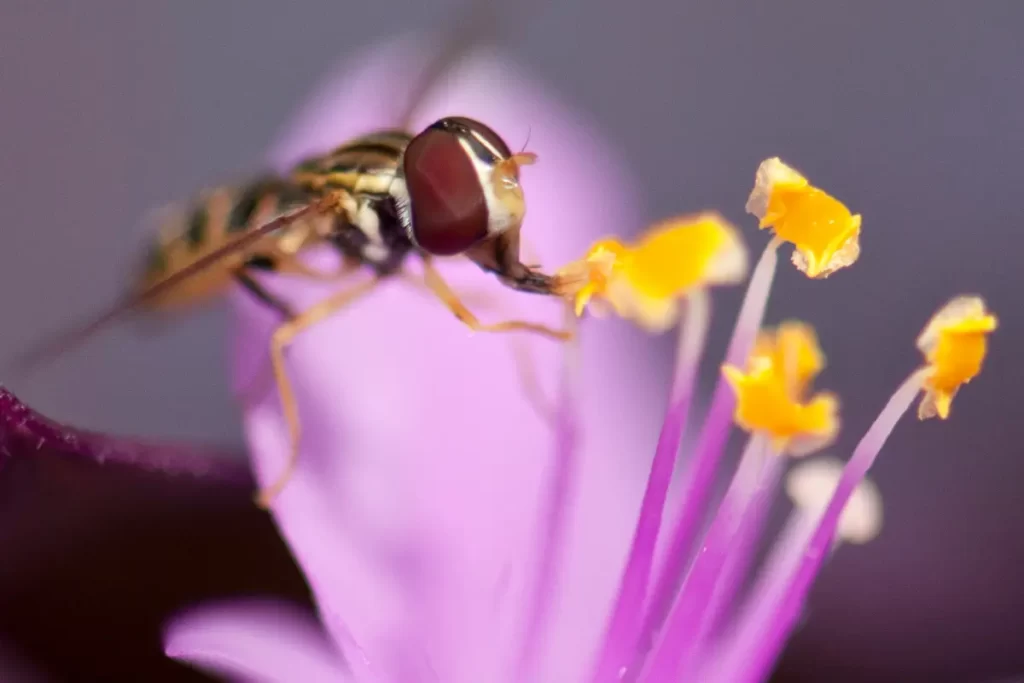
Wasps have a remarkable ability to adapt to diverse environments, but like any creature, they have specific preferences when it comes to their living conditions. These preferences can be best understood when we look at the different aspects of their environment that they find favorable. These preferred conditions ensure that wasps can find adequate food, shelter, and breeding grounds to sustain their populations.
| Condition | Preference |
| Temperature | Moderate climates are favored, avoiding extreme cold or heat. |
| Humidity | Balanced moisture: not too dry, but not overly wet either. |
| Shelter | Areas with ample hiding spots, like under bark, in hollowed trees, or human-made structures. |
| Food Availability | Proximity to plants for nectar or areas with a high insect population for predation. |
| Water Source | Access to freshwater sources, even if it’s just dew or small puddles. |
| Disturbance | Places with minimal interference, away from constant human activity or large predators. |
| Breeding Grounds | Quiet spots with materials like mud or wood for nest-building and laying eggs |
By understanding these preferred conditions, we not only gain insights into the life of the wasp but can also better manage our spaces if we wish to either attract or repel these insects. It’s this intricate dance with nature, understanding, and respecting each creature’s unique needs and preferences, that helps maintain a harmonious balance in our shared world.
Diet and Hunting of Green-Eyed Wasp
Wasps eat many different things. Some like to drink from plants, while others prefer to catch and eat smaller bugs. By eating certain bugs, they help keep those bug numbers in check, which is good for nature’s balance. Wasps are also very good at finding and catching their food.
What Does Green-Eyed Wasp Eat?
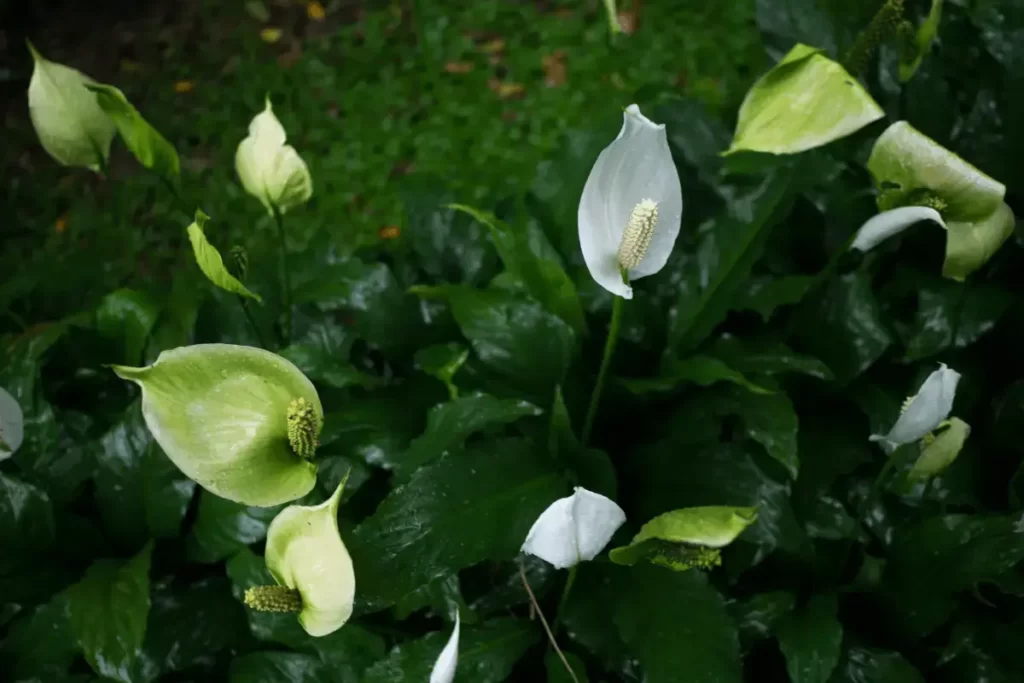
| Food Type | Details |
| Nectar | A primary energy source for many adult wasps. |
| Insects | Caterpillars, spiders, and various small bugs. |
| Honeydew | Sugary liquid produced by aphids or scale insects. |
| Fruit | Some wasps are attracted to ripe fruits. |
| Meat | Occasionally, scavenging on animal carcasses. |
Hunting Techniques
Wasps have their ways of finding food. They often fly around looking for moving bugs. When they spot one, they quickly move in to catch it.
If the bug is flying, the wasp uses its fast flying skills and good eyesight to grab it out of the air. Bugs on the ground aren’t safe, either. Wasps are good at moving on the ground to catch these bugs.
Some wasps even have special ways to hunt. For example, there’s a type of wasp that looks for spiders. When it finds one, it stings the spider to make it stop moving. Then, it carries the spider back to its home to feed its baby wasps.
With all these ways of hunting, wasps show us how smart and good they are at catching food. They are one of the best hunters in the insect world.
Social Structure of Green-Eyed Wasp
Wasps have interesting ways of living. Some like to be alone, while others live together in groups. In these groups, each wasp has a special job. The queen wasp lays eggs. Worker wasps, which are girls that usually don’t lay eggs, find food, look after baby wasps, and keep their home safe. Boy wasps mainly mate with new queens.
Colonies and Communication
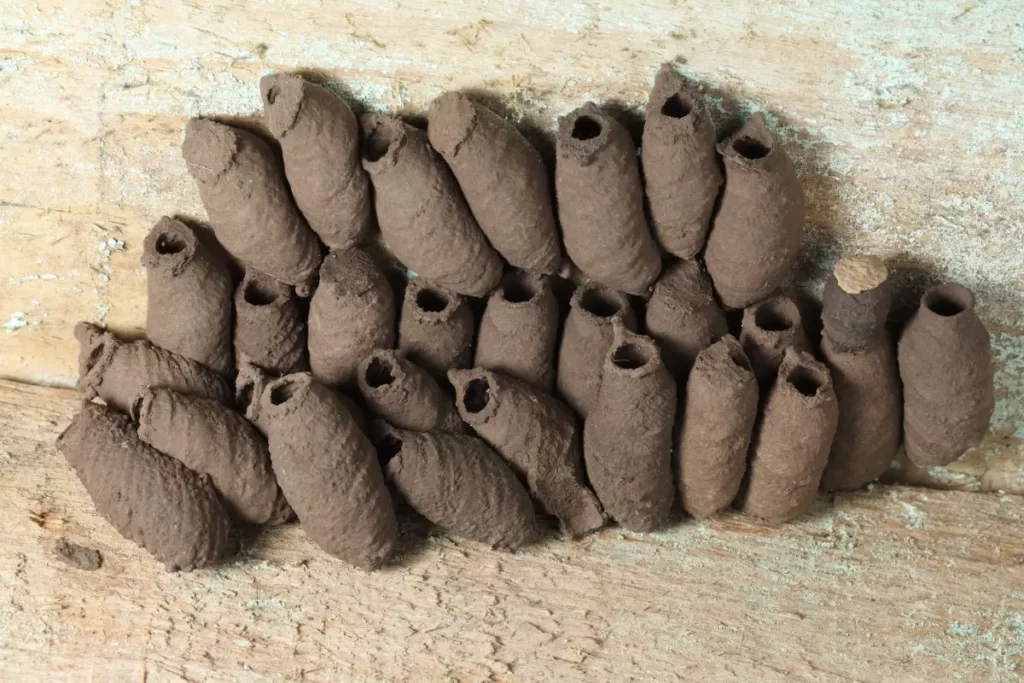
Wasps live in groups called colonies. A colony starts when a queen chooses a good place for a home and begins laying eggs. As more eggs hatch into workers, the home gets bigger.
Wasps need to talk to each other in their colony, and they do this using smells called pheromones. These smells can tell other wasps about danger or where to find food. They also touch each other, like tapping, to send messages. This helps everything run smoothly in their home.
Mating and Reproduction
Mate Search: When it’s time to have baby wasps, boy wasps, and new queen wasps leave their home to find a partner.
Mating Flight: These new queens and boys fly together on a special flight. The boys can find the queens because they give off a special smell.
Fertilization: When they pair up, the boy gives the queen his sperm. The queen keeps this in a special place in her body. She uses it to make her eggs grow for her whole life.
Establishing a New Colony: After they join, the boy wasp’s job is done and he usually doesn’t live much longer. The queen, now with her eggs ready, looks for a place to make a new home. She starts building it and lays her eggs inside.
Egg Development: The eggs become baby wasps called larvae. At first, the queen feeds them. But once the first grown-up worker wasps come out of their eggs, they feed the new babies. This lets the queen just focus on laying more eggs.
Colony Expansion: More and more worker wasps are born, so the family gets bigger. The queen lays two kinds of eggs. Some, when they hatch, will be girl wasps or new queens. Others will be boy wasps.
Cycle Continuation: At the end of the season, new queens and boy wasps are born. After they join up, the new queens go to sleep for the winter. They wake up next year to start their own families, and the cycle begins again.
Looking at how wasps live, from how they work together to how they start families, shows how smart nature is. Every little thing wasps do helps them live and keep having baby wasps.
Interaction with Humans

You might see wasps at picnics, gardens, or other outdoor places. This isn’t because they want to bother us. They’re curious about the smells and tastes we bring. Maybe they like our sweet drinks, or they’re after tiny bugs near us. Remember, wasps aren’t naturally mean. They come close because they’re looking for food.
Are Green-Eyed Wasp Harmful?
Just because a wasp is near doesn’t mean it wants to hurt you. But yes, if a wasp feels scared, it might sting. A sting can make your skin hurt, turn red, and puff up. Some people are allergic to wasp stings. They might feel sick and need a doctor. Some wasps might also be pests, especially if they make nests in our homes or go after our food. But there’s a good side, too. Wasps eat many bugs that are pests. This helps keep everything in nature balanced.
So, while wasps can be a bother, they also do helpful things in nature. It’s always good to know how to be safe around them.
Coexisting Safely
Wasps are a part of our world, and we can live safely with them. Here are easy steps to make sure both humans and wasps stay safe:
1. Stay Calm: Remember, wasps aren’t out to get us. They usually only sting if they feel threatened. Try not to wave your arms or move quickly near them.
2. Keep Food Covered: If you’re eating outside, put a lid on your food. Wasps love sweet things like soda or fruit, so be extra careful with those.
3. Be Smart About Nests: Found a wasp nest at your place? Don’t touch it. If it’s in a tricky spot and you’re worried, call someone who knows how to move it safely.
4. Talk About Wasps: Make sure everyone in your family, especially kids, knows about wasps. When we understand something, we’re less likely to be afraid of it.
5. Use Plants: Some plants, like spearmint and eucalyptus, can help keep wasps away. Think about adding them to your yard or garden.
By following these tips and understanding wasps better, we can make sure everyone stays safe and happy.
Conservation
Everything in nature, big or small, has its purpose. The Green-Eyed Wasp is a tiny creature with a big job. They help plants grow by pollinating them, controlling other pests, and providing food for other animals. This makes them super important to our environment.
Threats to the Green-Eyed Wasp
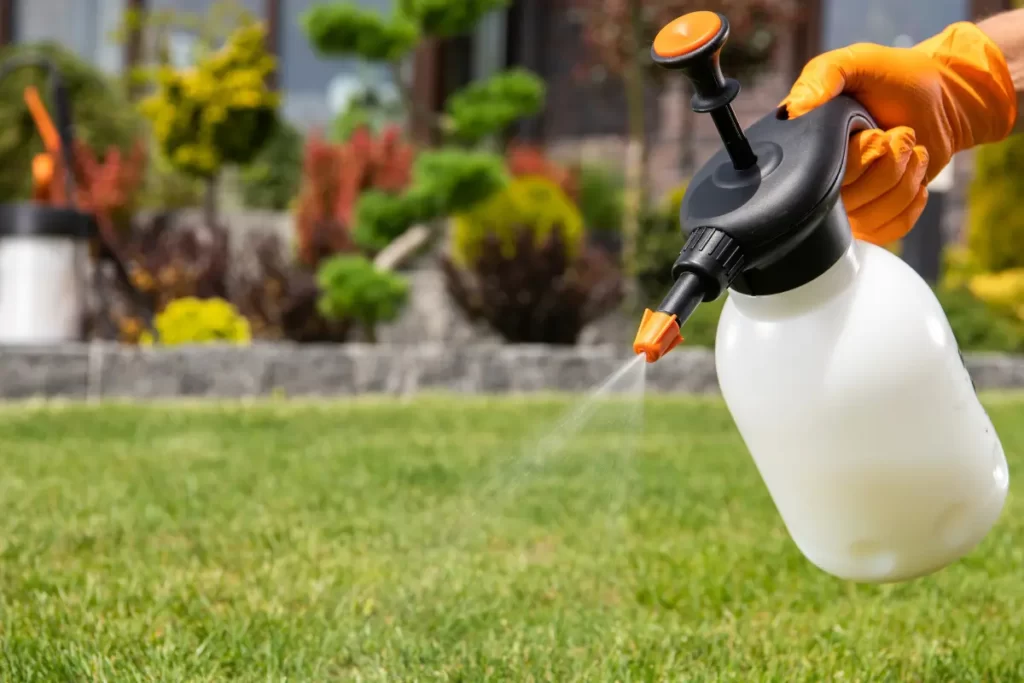
Sadly, our Green-Eyed Wasps are facing some tough times. Here’s what’s causing problems:
1. Losing Their Homes: As more cities grow and trees get cut down, these wasps are losing their natural spaces. This means less food, fewer places to live, and more dangers from other animals.
2. Harmful Sprays: When farmers use strong chemicals to keep bugs away from their crops, these sprays can hurt our Green-Eyed Wasps. They might get sprayed directly or eat bugs that have been sprayed.
3. Changing Weather: Our planet is getting warmer, and this change in weather can make it hard for wasps to find food mates or lay their eggs properly.
4. People Being Scared: Yes, wasps can sting. But they usually don’t unless they’re scared. Sometimes, people harm wasps or destroy their nests because they’re afraid of getting stung.
By understanding these issues and working to fix them, we can help keep our Green-Eyed Wasps safe and doing their important work in nature.
Conservation Efforts
The Green-Eyed Wasp is important, and we need to make sure it stays around for a long time. Here’s what we can do:
1. Teach People: Let’s tell everyone how good wasps are for nature. If people know they’re helpful and not just out to sting them, they’ll be kinder to wasps.
2. Farm the Right Way: Farmers can use fewer chemicals that hurt wasps. Growing food in natural ways is safer for these little helpers.
3. Fix Their Homes: We can plant more trees and flowers than the wasps like. If we fix places that people have messed up, wasps will have more spaces to live.
4. Keep Checking on Them: Scientists can study wasps to learn more about them. By watching them closely, we’ll know how to help better.
5. Make Rules to Protect Them: Even though they’re small, wasps can get special laws to keep them safe, especially if they’re in big danger in some places.
If we do all these things, we’re not just helping the Green-Eyed Wasp. We’re showing that we care about every living thing, no matter how small.
How to Get Rid of Green-Eyed Wasp?
Use Nature’s Tricks
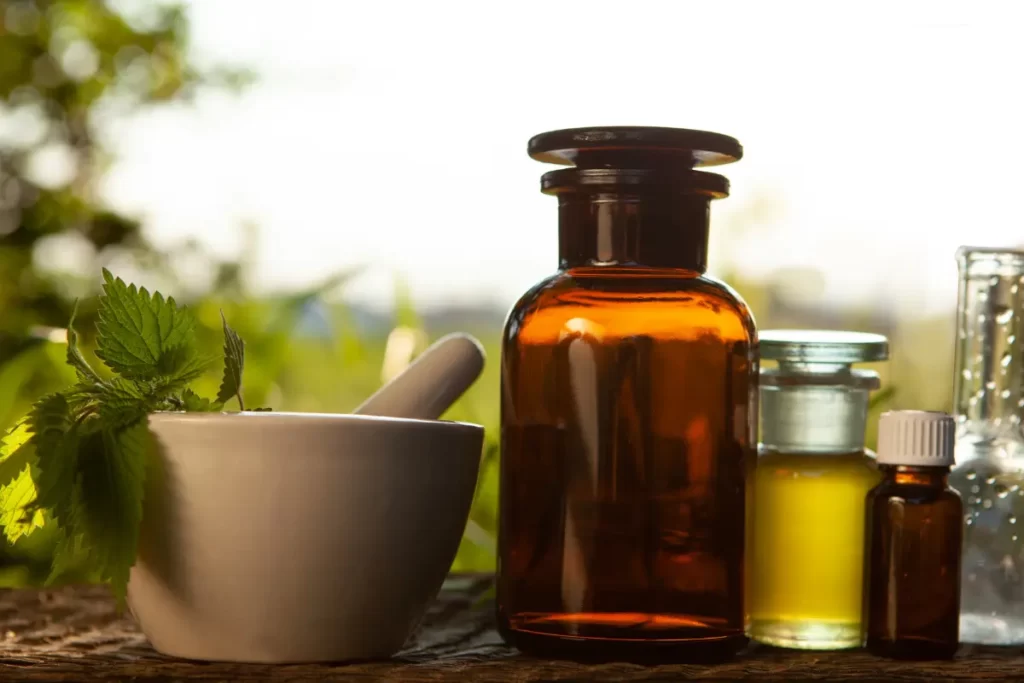
Mother Nature gives us things to help keep wasps away without hurting them.
- Peppermint Spray: Wasps don’t like peppermint. Humans, however, love its smell. Mix some peppermint oil with water in a spray bottle. Spray it around places you sit outside and near windows and doors. Doing this often will keep your area clear of wasps.
- Lemon and Clove Mix: Cut a lemon in half and put cloves in it. Wasps don’t like this smell at all. Put these lemon halves where wasps come often, and they’ll stay away.
Keep Your Area Clean

Stopping wasps from coming near your home is easier if you keep things clean.
- Tight-Lid Trash Cans: Wasps like leftover food, especially meat and sweet things. Keep your trash can lids tight so wasps can’t get in. Empty your trash often, too.
- Cover Your Food: If you eat outside, keep your food covered. Clean up right away if something spills, especially if it’s sweet. Wasps love sweet things.
- Look for Nests: Every so often, look around your house for wasp nests. If you see lots of wasps in one place, there might be a nest nearby. It’s easier to get rid of small nests than big ones.
DIY Wasp Catchers
You can make your wasp traps. They work well and don’t harm the environment.
- Sweet Water Trap: Fill a jar with sugar water. Put a lid with a small hole in the jar. Wasps will go in because they like the sweet water, but they’ll have a hard time getting out. Keep these jars away from where people sit. Also, clean the jars now and then.
The Magic of Diatomaceous Earth
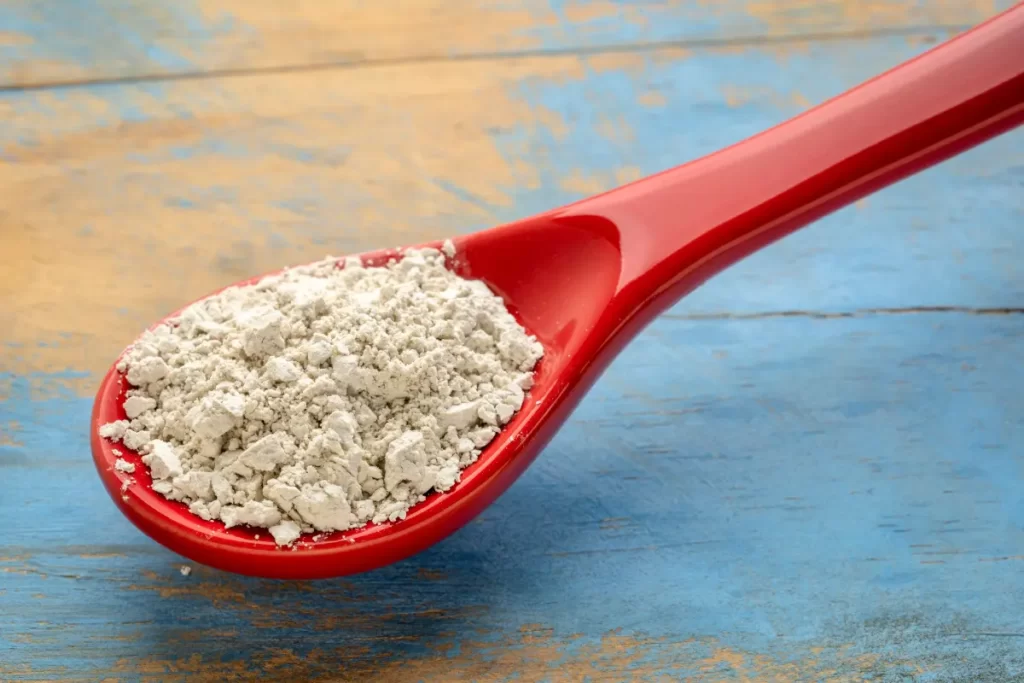
What’s Diatomaceous Earth (DE)? DE is a natural powder made from tiny, old water creatures called diatoms. When wasps touch this powder, it soaks up the oils from their outer shell. This makes them dry out and they can die.
How to use it: Spread DE where you see wasps or think there might be a nest. Remember two things:
- Keep the DE dry. If it gets wet, it won’t work well.
- Always choose the kind of DE that’s safe for eating. This way, it’s safe for people and pets too.
Hang Fake Wasp Homes
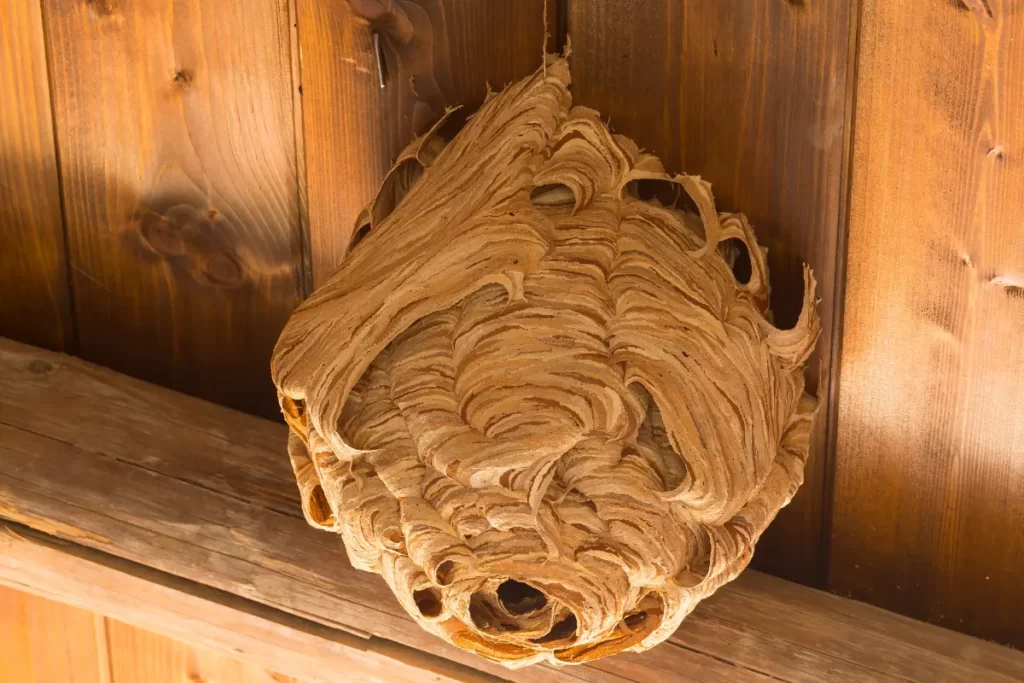
Why Fake Nests? Wasps don’t like to live too close to other wasps. If they see a nest, they’ll think another wasp lives there, and they’ll stay away. You can buy these pretend nests at most garden or hardware stores. Put them up around your yard, especially in places where wasps like to make homes, like under roof edges or in trees.
Plant Some Wasp-Scaring Plants
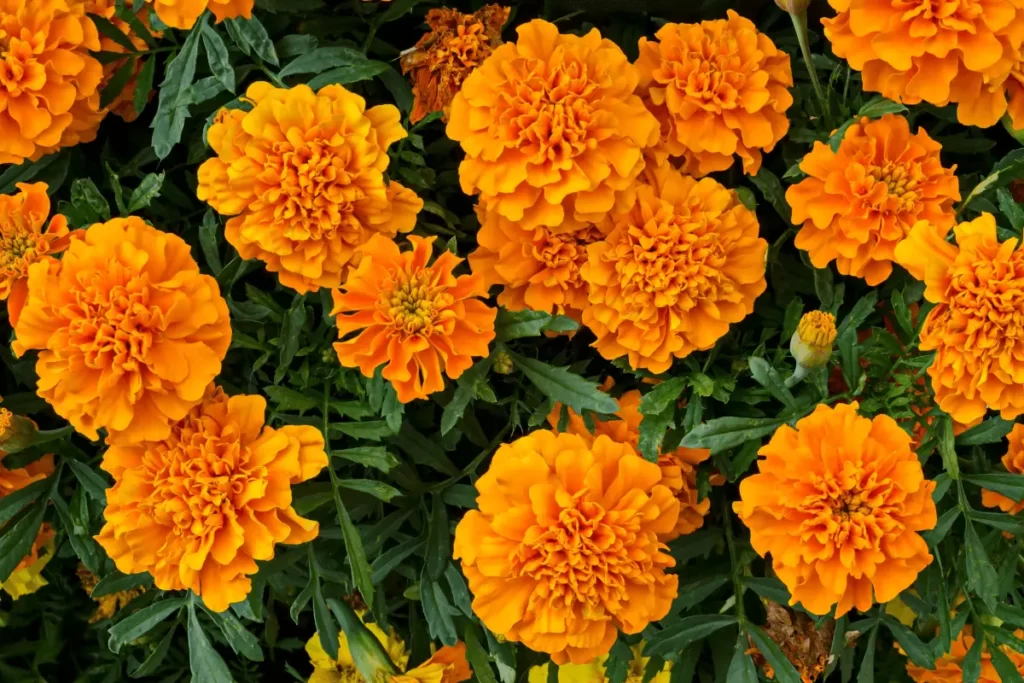
Special Plants: Some plants make wasps want to stay away. Plants like wormwood, marigold, and eucalyptus are great for this. If you put these plants in your garden or in pots by your doors, you’ll see fewer wasps.
Put Up Screens or Nets
Keep Wasps Out: If you love being outside but don’t like wasps, screens or nets can help. They stop wasps from getting into places like patios or decks. This way, you can enjoy outside without wasps bothering you.
Try a Vinegar Spray

How It Works: Just like the soap spray, wasps don’t like vinegar. Mix the same amount of water and white vinegar in a spray bottle. Spray it around places where you sit outside and near doors or windows. Wasps won’t like the smell and will stay away.
A Simple Spray: Soap and Water
Why Dish Soap Works: Mixing water and dish soap makes a spray that can stop wasps. The soapy water blocks their airways, so they can’t breathe.
Here’s what to do: Fill a spray bottle with water and lots of dish soap. If you see a wasp, spray it with this mix. This works great for a few wasps, but maybe not a whole nest.
Check and Fix Your Home
Keep Them Out: To stop wasps from moving in, make sure they can’t get inside. Look around your house for small openings, especially near windows, doors, and the roof. If you find any, seal them up. This keeps wasps from making a home near yours.
When to Call the Pros

Getting Expert Help: If there’s a big nest or too many wasps for you to handle, it’s a good idea to call professional bug experts. They know the best ways to get rid of wasps safely. They can also give tips on how to keep wasps away in the future.
| Method | Description |
| Citrus Essential Oils | Wasps dislike strong citrus scents. Use a blend of citrus oils like lemon or orange mixed with water as a repellent. |
| Cucumber Slices | The natural acid in cucumber is a deterrent for wasps. Place slices where wasps frequently appear. |
| Baby Powder | Sprinkle around areas where you want to deter wasps. They dislike the texture and scent. |
| Red Pepper Spray | Mix red pepper and water, then spray in areas of wasp activity. They’re repelled by the spicy nature of the mixture. |
| Soda Bottle Trap | Cut the top off a soda bottle, invert it, and place sweetened water inside. Wasps enter but cannot exit. |
| Talcum Powder | Apply in areas where wasps might nest. They dislike the texture and will avoid the area. |
| Mothballs | Hang them in a porous bag in areas of wasp activity. Their scent repels many pests, including wasps. |
| Coffee Grounds | Burn coffee grounds in a fire-safe container. The smoke and strong aroma can deter wasps from the area. |
Remember, it’s essential to use these methods responsibly. Many are deterrents rather than lethal solutions, prioritizing coexistence with the wasps rather than their elimination.
How To Get Rid of Green-Eyed Wasp Sting?
1. Stay Cool and Calm: After a wasp sting, it’s normal to feel scared, especially if it’s your first time. But try to stay relaxed. If you panic, the sting might hurt more. Just breathe slowly and move away from the wasp.
2. Check for the Stinger: Most times, wasps don’t leave their stinger in you. But if they do, scrape it out gently with a card edge or your nail. It’s best not to use tweezers because it might squeeze out more sting stuff.
3. Wash the Sting Spot: Use soap and cool water to clean where the wasp stung you. This will help wash away some sting stuff and keep the area clean. Then, pat it dry with a clean towel.
4. Use Cold to Help: A cold pack or ice in a cloth can make the sting feel better. Remember to put something like a shirt between the ice and your skin. This stops your skin from getting too cold. Hold the cold thing on the sting for about 10 minutes, but take short breaks.
5. Think About Pain Medicine: If it still hurts, you can take some pain medicine from the store, like ibuprofen. Just make sure to read the instructions and check for stuff you might be allergic to.
6. Creams Can Help: Creams like hydrocortisone or calamine lotion can help if the sting spot is itchy or swollen. You can get these at most drug stores.
7. Watch for Allergies: Some people might be allergic to wasp stings. Look for signs like having a hard time breathing, getting hives, face or lips swelling, a fast heartbeat, feeling dizzy, or feeling like throwing up. If you see any of these signs, go to a doctor right away.
8. Don’t Scratch: Even if the sting itches, try not to scratch. Scratching can make it take longer to heal. If the itching is too much, use the creams we talked about or ask a drugstore person for something to help with itching.
9. Look for Signs of Infection: In the next few days, see if the sting spot looks red, warm, has pus, or hurts more. If you see these signs, talk to a doctor.
Remember, a Green-Eyed Wasp’s sting can be surprising and painful, but if you follow these easy steps, you’ll feel better soon. If you’re unsure about anything, always ask a doctor for help.
Other Wasp Types Found in The USA
We have written detailed guidelines about other types of wasps found in the USA. You can find everything about these species here:
Conclusion
Green-eyed wasps are amazing creatures with a special place in our world. From our journey, we’ve learned so much about these wasps. They are not only beautiful but also play a big role in nature by helping plants grow and keeping other bugs in check.
But, like many animals, they have their own set of problems when it comes to living with humans. Yes, they can sting, and this can be a worry, especially for people who might be allergic. However, by learning about them, like what they eat and where they live, we can live side-by-side without too many problems.
In the end, Green-Eyed Wasps are more than just bugs. They show us how everything in nature is connected. By understanding and respecting them, we can make our world a place where all creatures, big and small, can live together happily.
